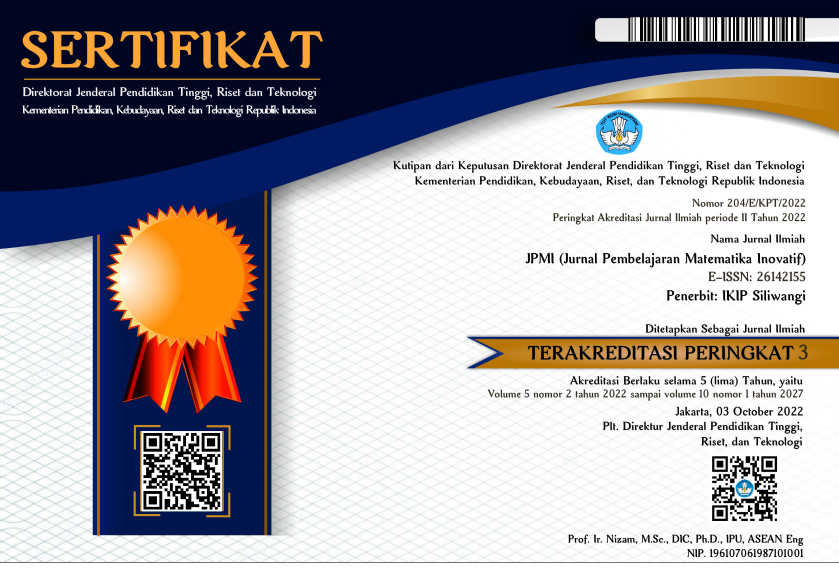ANALISIS MOTIVASI BELAJAR SISWA SMP KELAS VIII BERBANTUAN POWER POINT INTERAKTIF PADA MATERI BANGUN RUANG SISI DATAR
DOI:
https://doi.org/10.22460/jpmi.v5i5.10608Kata Kunci:
Learning Motivation, Flat Side Space Shape, Interactive PowerpointAbstrak
This study aims to dissect students' learning inspiration on the material for building flat sides with the help of interactive Powerpoint. The method used in this exam is a qualitative descriptive technique. The subjects of this study were 6th grade students of SMP Negeri 1 Ciwidey, consisting of 2 male students and 4 female students. The information retrieval technique uses a student learning motivation scale on the flat-sided building material assisted by interactive Powerpoint media which contains 10 statements with 5 positive statements and 5 negative statements. The results of data analysis in this study indicate that students are included in the very good category, which is 82.1% of the results of calculations using Microsoft Excel. Utilization of interactive Powerpoint media can help students in learning the material for building flat sides.
Referensi
Budiariawan, I. P. (2019). Hubungan Motivasi Belajar dengan Hasil Belajar pada Mata Pelajaran Kimia. Jurnal Pendidikan Kimia Indonesia, 3(2), 103–111. https://doi.org/10.23887/jpk.v3i2.21242
Dewi, D. K., Khodijah, S. S., & Setiawan, W. (2020). Analisis Motivasi Belajar Matematika Siswa SMA Bingkai Cendekia Cililin Berbantuan Aplikasi Geogebra pada Materi Transformasi Geometri. Jurnal Pembelajaran Matematika Inovatif, 3(1), 49–58. https://doi.org/10.22460/jpmi.v3i1.p49-58
Dewi, N. L. P. S., & Manuaba, I. B. S. (2021). Pengembangan Media Pembelajaran Powerpoint Interaktif Pada Mata Pelajaran IPA Siswa Kelas VI SD. Jurnal Penelitian dan Pengembangan Pendidikan, 5(1), 76–83. https://ejournal.undiksha.ac.id/index.php/JJL/article/view/32760
Fadillah, N. N., Triyulia, F., Sholehah, A. A., & ... (2021). Penggunaan Powerpoint sebagai Media Pembelajaran Daring untuk Mengembangkan Motivasi Belajar di TK Plus Roudhoh. Indonesian Journal of Community Services in Engineering and Education (IJOCSEE), 1(2), 161–166. https://ejournal.upi.edu/index.php/IJOCSEE/article/view/33336
Hendriana, H., Rohaeti, E. E., & Sumarmo, U. (2017). Hard skills dan soft skills matematik siswa. Bandung: Refika Aditama.
Khoirul, B., & Risma, A. (2020). Analisis Kesalahan dalam Menyelesaikan Soal Bangun Ruang Sisi Datar pada Siswa Kelas IX SMP di Kota Cimahi 1,2. Jurnal Pembelajaran Matematika Inovatif, 3(5), 403–414. https://doi.org/10.22460/jpmi.v3i5.403-414
Latifah, S., & Utami, A. (2019). Pengembangan Bahan Ajar Interaktif Berbasis Media Sosial Schoology. Indonesian Journal of Science and Mathematics Education, 2(1), 36–45. https://doi.org/10.24042/ijsme.v2i1.3924
Mulyana, U. R., & Fitrianna, A. Y. (2019). Hubungan Motivasi Belajar Terhadap Kemampuan Pemecahan Masalah Matematik Siswa SMP pada Materi Segitiga Segiempat. Jurnal Pembelajaran Matematika Inovatif, 2(6), 415–420.
Nurlaila S, Sariningsih, R. M. (2018). (2018). Analisis Kemampuan Komunikasi Matematis Siswa SMP Terhadap Soal-Soal Bangun Ruang Sisi Datar. Jurnal Pembelajaran Matematika Inovatif, 1(6), 1113–1120.
Pamungkas, R. A., Kulsum, S. I., Chotimah, S., Terusan, J., Sudirman, J., & Barat, J. (2020). Analisis Penggunaan Media Pembelajaran Berbasis VBA For Excel Terhadap Motivasi. Jurnal Pembelajaran Matematika Inovatif, 3(5), 393–402. https://doi.org/10.22460/jpmi.v3i5.393-402
Salbiah, A. O., Masruroh, A. A., & Chotimah, S. (2021). Analisis Motivasi Belajar Siswa Terhadap Pembelajaran FPB dan KPK dengan Menggunakan VBA For Excel. Jurnal Pembelajaran Matematika Inovatif, 4(5), 1327–1336. https://doi.org/10.22460/jpmi.v4i5.1327-1336
Sucipto, H. H. (2019). Analisis Kesulitan Belajar Matematika Siswa pada Materi Bangun Ruang Sisi Datar Ditinjau Dari Kemampuan Komunikasi Matematis. Factor Action Of Research Matheamtic, 1(2), 81–98. https://doi.org/10.30762/f_m.v1i2.1440
Utami, Y. R., & Fitrianna, A. Y. (2021). Menyelesaikan Soal Matematika Materi Bangun Ruang Sisi Datar pada Pandemi Covid-19. Jurnal Pembelajaran Matematika Inovatif, 4(5), 1245–1254. https://doi.org/10.22460/jpmi.v4i5.1245-1254

















